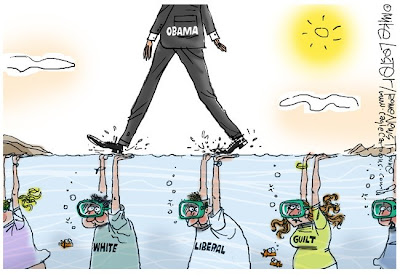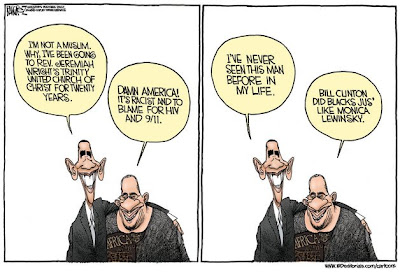We’ve blogged about how
politically correct types at Marquette discuss rape in their dissent-free “critical thinking forbidden” events.
Theresa Tobin, for example, proclaimed that
all men are are implicated as rapists. As we described it:
Tobin rejected the notion that rapes should be seen as “acts of morally corrupt individuals.” Yes, guys, the fact that you have never raped any women and would never rape any woman doesn’t let you off the hook. You are still part of the “deep social and political causes” of rape.
Why? Because you are part of a system that involves the “use of violence to keep systems of oppression in place.”
In fact, according to Tobin, you are part of a “protection racket.” Because of the threat of rape, a woman “needs to be protected by men against other men.”
And what is wrong with men protecting women against rape? For Tobin, the system “forces compliance with traditional norms.” And further, “the penalty for being protected is to conform.”
At that same event, R. Clifton Spargo, representing another hyper-politically correct department (English) said some equally silly things.
While he didn’t exactly accuse all men of being rapists, like Tobin he got pretty close.
He rejected the notion that rape is “merely aberrant, deviant behavior,” and told the male members of the audience “you are living in the rape culture.” Where? “On Campus. In the bars.”
Happily, not everybody in the world buys into the rape hysteria. An interesting
column in the Los Angeles Times challenged some of the blather.
It’s a lonely job, working the phones at a college rape crisis center. Day after day, you wait for the casualties to show up from the alleged campus rape epidemic -- but no one calls. Could this mean that the crisis is overblown? No. It means, according to campus sexual-assault organizations, that the abuse of coeds is worse than anyone had ever imagined. It means that consultants and counselors need more funding to persuade student rape victims to break the silence of their suffering.
It is a central claim of these organizations that between a fifth and a quarter of all college women will be raped or will be the targets of attempted rape by the end of their college years. Harvard’s Office of Sexual Assault Prevention and Response uses the 20% to 25% statistic. Websites at New York University, Syracuse University, Penn State and the University of Virginia, among many other places, use the figures as well.
If the one-in-four statistic is correct, campus rape represents a crime wave of unprecedented proportions. No felony, much less one as serious as rape, has a victimization rate remotely approaching 20% or 25%, even over many years. The 2006 violent crime rate in Detroit, one of the most violent cities in the U.S., was 2,400 murders, rapes, robberies, and aggravated assaults per 100,000 inhabitants -- a rate of 2.4%.
Such a crime wave -- in which millions of young women would graduate having suffered the most terrifying assault, short of murder, that a woman can experience -- would require nothing less than a state of emergency. Admissions policies, which if the numbers are true are allowing in tens of thousands of vicious criminals, would require a complete revision, perhaps banning male students entirely. The nation’s nearly 10 million female undergraduates would need to take the most stringent safety precautions.
None of this crisis response occurs, of course -- because the crisis doesn’t exist.
So where do the numbers come from? During the 1980s, feminist researchers committed to the rape-culture theory discovered that asking women directly if they had been raped yielded disappointing results -- very few women said that they had been. So Ms. magazine commissioned University of Arizona public health professor Mary Koss to develop a different way to measure the prevalence of rape.
Rather than asking female students about rape per se, Koss asked them if they had ever experienced actions that she then classified as rape. One question, for example, asked, “Have you had sexual intercourse when you didn’t want to because a man gave you alcohol or drugs?” -- a question that is ambiguous on several fronts, including the woman’s degree of incapacitation, the causal relation between being given a drink and having sexual intercourse, and the man’s intentions. Koss’ method produced the 25% rate, which Ms. then published.
It was a flawed study on a number of levels, but the most powerful refutation came from her own subjects: 73% of the women whom the study characterized as rape victims told the researchers that they hadn’t been raped. Further, 42% of the study’s supposed victims said they had had intercourse again with their alleged assailants -- though it is highly unlikely that a raped woman would have sex again with the fiend who attacked her.
Despite all this, the numbers have stuck. Today, John Foubert, an education professor at William and Mary College (and founder of a group called One-in-Four, which works on sexual assault issues and has chapters on 17 campuses), says, “The one-in-four statistic has been replicated in several studies for several decades. To the extent that social science can prove anything, which I believe it can, the one-in-four statistic has been proven beyond all reasonable doubt. My instincts tell me that the statistic is actually much higher.”
Yet subsequent campus rape studies keep turning up the pesky divergence between the victims’ and the researchers’ point of view.
A 2006 survey of sorority women at the University of Virginia, for example, found that only 23% of the subjects whom the survey characterized as rape victims felt that they had been raped -- a result that the university’s director of sexual and domestic violence services calls “discouraging.” Equally damning was a 2000 campus rape study conducted under the aegis of the Department of Justice. Sixty-five percent of those whom the researchers called “completed rape” victims and three-quarters of “attempted rape” victims said that they did not think that their experiences were “serious enough to report.”
Believing in the campus rape epidemic, it turns out, requires ignoring women’s own interpretations of their experiences.
There is a simple principle here: if a feminist political activist has to explain to you that what happened was rape, it wasn’t.
What is really behind all this campus sex, if not rape. The answer is politically incorrect.
So what reality does lie behind the rape hype? I believe that it’s the booze-fueled hookup culture of one-night, or sometimes just partial-night, stands. Students in the ‘60s demanded that college administrators stop setting rules for fraternization. The colleges meekly complied and opened a Pandora’s box of boorish, promiscuous behavior that gets cruder each year.
This culture has been written about widely. College women -- as well as men -- reportedly drink heavily before and during parties. For the women, that drinking is often goal-oriented, suggests Karin Agness, a recent University of Virginia graduate and founder of NeW, a club for conservative university women: It frees the drinker from responsibility and “provides an excuse for engaging in behavior that she ordinarily wouldn’t.” Nights can include a meaningless sexual encounter with a guy whom the girl may not even know.
In all these drunken couplings, there may be some deplorable instances of forced and truly non-consensual sex. But most campus “rape” cases exist in the gray area of seeming cooperation and tacit consent, which is why they are almost never prosecuted criminally.
“Ninety-nine percent of all college rape cases would be thrown out of court in a twinkling,” observes University of Pennsylvania history professor Alan Kors.
Feminists, knowing that something is wrong, but being unwilling to condemn sexual promiscuity or ever admit that women can be at fault for the bad things that happen to them, have to avoid the issue, and fuss and fume about a “culture of rape.”
“Culture of promiscuity” just isn’t politically acceptable to them.
The
LA Times article was, not surprising, met with a rather hysterical response. Marquette feminist blog
“Word Warrior” fumed “This just makes me livid. I am so pissed right now, that words right order in the can’t put I.”
It went on:
MacDonald’s primary argument is that women are as much of a participant in alcohol-fueled rapes as men, and that these assaults thus take place in the “gray area” of rape. First of all, there is no “gray area” of rape. Consent is consent, and lack of consent is lack of consent. If a woman is too drunk to consent, then that is rape.
Our students, when faced with this argument, are more sensible. We ask about a situation in which a guy and gal go out and drink too much. They then go back to his apartment and both voluntarily get into bed and have sex.
Feminist doctrine says he raped her.
My students ask, “why? Wasn’t it mutual? Why can’t we say that she raped him?”
The feminist answer, and this is degrading to women, is that a woman is always be assumed to be the victim. The man can be held responsible for his actions, but the woman can’t.
“Word Warrior” goes on:
Second of all, to argue that a woman is complicit in rape will merely exacerbate the rape crisis.
Of course, this begs the question of whether what happened is “rape.”
But telling women that if they get drunk and go to bed with some schlub they don’t know and don’t particularly like they will get little sympathy sounds to us like a dandy response to the “rape crisis.” But the fundamental argument from the feminists is the typical politically correct one: “if we talk honestly about this, it will hurt our political agenda.” This is the same sort of mentality that doesn’t want to talk about the fact that blacks commit more crimes than whites (which causes disproportonate incarceration) or that child abuse typically comes from a mom’s live-in boyfriend, and happens very seldom when mom is married to and living with the child’s biological father.
The Feminist AgendaThe campus blather about the “rape crisis” reflects two very important things about academic feminists.
First, it crystallizes the feminist notion that women are the victims of evil, brutal males.
But perhaps more important is that it can be used as a tool to increase the feminist infrastructure on campus.
“Word Warrior” is
adamant that Marquette needs a whole office, a Women’s and/or Gender Relations Resource Center on campus.
More jobs for feminists. And a source of activism not only “against rape” but in favor of abortion, gay marriage and pretty much every other politically correct piece of the feminist agenda.
In fact, such “centers”
get little business.
Needless to say, those facilities don’t appear to get a tremendous amount of use. For example, Hillary Wing-Richards, the associate director of sexual-assault prevention at James Madison University, said the school’s campus rape “help line” gets a varying number of calls, some of which are “request-for-information calls” -- where to go, who to talk to and the like.
“Some months there are 10 and others, one or two,” she said.
Referring to rape hotlines, risk management consultant Brett Sokolow laments: “The problem is, on so many of our campuses, very few people ever call. And mostly we’ve resigned ourselves to the underutilization of these resources.”
Real rape, something vastly rarer than the feminist notion of “rape,” should be dealt with as a law enforcement issue. And not by feminist bureaucrats, but rather by tough cops, who may be women, but are unlikely to be feminists.
Labels: Feminism, Feminists, Marquette blogs, Marquette University, Political Correctness, Rape








